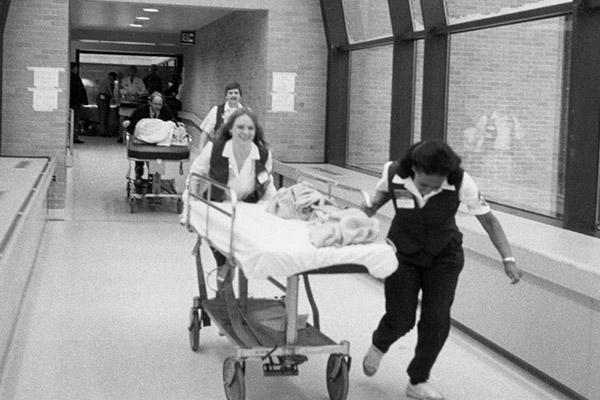
Dr. Sofia Merajver
Dr. Sofia Merajver was a third-year medical student and mid-way through her Oncology rotation in February of 1986, just as U-M was in the midst of opening its brand new $285 million hospital. Valentine's Day that year will always stand out to her, not for any gift she received, but for her role in the gift she and others helped to give so many critically ill patients.
"I was moving those patients assigned to me along corridors connecting to the shiny new hospital. It was a very proud moment when the move in our ward ended and everyone was fine, as our patients were among the most frail," said Dr. Merajver, today a professor of Medical Oncology at UMHS. "They understood they were part of history and it was very emotional to see how they rallied and how excited they were to be such pioneers."
The move was crazy, but the transition was seamless
Feb. 14 marked 30 years since the facility known today as University Hospital opened its doors along with the A. Alfred Taubman Center. It was a significant milestone for UMHS, for its then 5,000 faculty and staff, and especially for the millions of patients to seek inpatient or outpatient care there in three decades since. After years of construction and months of planning, the last 400 patients from the former "Old Main" hospital moved into the new 11-story facility during a single long day on Feb. 14, 1986. Everyone pitched in to ensure a smooth, safe, and seamless transition.
"The move was crazy. Patients were being transported through hallways all day long," said Eva Kline-Rogers, Nurse Practitioner at U-M Cardiology Domino Farms. "It was especially challenging because we were in the midst of an acute clinical trial which required 24/7 coverage and had to figure out a way to have both cath labs operating and available simultaneously. It was one of the most logistically difficult challenges I've ever faced."
It isn't hard to find people who were part of that opening team from 30 years ago; more than 1,000 of them – one fifth of the entire Old Main workforce from 1986 – are still on the team today.
"My husband was a patient and part of the big move from the old hospital to the new one," said Ellen, a university employee recalling the new facility opening. "His nurse the first time he was hospitalized 30 years ago was his nurse again when we found ourselves back in the hospital 25 years later. That's some pretty good continuity of care!"
When it closed in 1986, Old Main was 61 years old. Longtime employees remembered it fondly for its hallways lined with color-coded tape, its often slow elevators manned by human attendants, and for its narrow, congested stairwells, lovingly dubbed "ureters," an anatomical inside joke. It took the faculty and staff some time to get used to their glistening new 840-plus bed hospital, known at that time simply as RHP, or Replacement Hospital Project. Just finding their way around was a challenge at first, recalled Linda Selwa.
"As a new person in the all-taupe new hospital, it took me months to learn to navigate well," she said. "I remember there were a few pictures in Radiology, and we would often advise people to 'Turn left at Greece to get to CT.'"
But the new, much larger hospital ushered in an era of unprecedented growth for UMHS, with subsequent physical enhancements to include the expanded Kellogg Eye Center and the C.S. Mott Children's Hospital along with numerous specialty centers for cancer, geriatrics, depression and more, all of which brought countless innovations in care and treatment and cemented U-M's reputation as a global healthcare leader.
"I will never forget that day I helped to open the new hospital. It helped make me a proud Wolverine," said Dr. Merajver. "We had a motto then: knowledge heals. I believe that motto still represents us well. The spirit of a teaching hospital – that we can handle any case, no matter how complex, that we can use science in the service of providing the best and most compassionate medical care – remains the same."
Photos courtesy of the Bentley Historical Library. This story appeared originally in Health System Headlines.